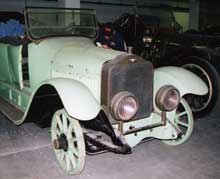Chances are, if you’re of certain age you associate the name “White” with trucks. For over seven decades, the White Motor Company built commercial vehicles, with very few exceptions. In the beginning, however, White vehicles were passenger cars.
In 1900, Rollin, Walter and Windsor White began building steam cars in their father’s Cleveland sewing machine factory. The White car was a bit more advanced than its main competition, the Stanley, using front mounted condensers from 1902 and fast-heating monotube boilers. But by 1910, the Whites could see that steam had a limited future and phased in an internal combustion car. The last steamer was built in January 1911.
The first White truck was a steam delivery van built in the second year of automobile manufacture. Increasingly larger trucks were offered, both steam and internal combustion, and the success of White trucks during World War I convinced the White Motor Company, as it was renamed in 1916, to concentrate on the heavy commercial market. White trucks were of conventional design, but through the 1920s incorporated a radiator of distinctive shape derived from the condenser of post-1904 steam cars. The White touring car atop this page is one of the last passenger vehicles, a 1917 model originally used by the U.S. Forest Service. It is currently owned by the County of Los Angeles and stored at LA’s Petersen Automotive Museum.
In 1936, Alexis de Sakhnoffsky restyled the cab of White trucks, a seminal design that would last into the 1950s. Specially-built White sightseeing buses became legendary at Yellowstone and Glacier National Parks, and when I was young a neighboring Connecticut town used nothing but White school buses. “White SUPER POWER” read the hood emblem, and diesel-powered trucks from 1949 proclaimed “White DIESEL POWER.” An attractive cab-over-engine model appeared around this time, and an innovative White Horse delivery truck, with rear-mounted air-cooled flat-four power, was produced from 1939-42 and in small numbers after the war. White was among the first to build tilt-cab trucks, introducing the 3000 series in 1949.
In the 1950s, White Motor Company went on a buying spree. The firm gobbled up Sterling in 1951, the same year a sales arrangement was inked with Freightliner. Autocar came into the fold in 1953; Reo in 1957 and Diamond T the following year. Engine manufacturer Hercules was purchased from Hupp Corporation in 1966, but spun off a decade later. In 1968, White took on General Motors’ off-road brand Euclid, though The General continued to build some products under the Terex name. That same year, Western Star was created as a model of White, producing heavy highway haulers for markets in western North America.
By the 1970s, the great White fleet was coming apart. Diamond Reo, as the two makes had become, was purchased by an Alabama investor in 1971. Euclid was sold to Daimler-Benz in 1977; it’s now owned by Hitachi. In 1981, bankruptcy became unavoidable. Sweden’s Volvo AB bought the remains, forming Volvo White Truck Corporation. Western Star was spun off in 1983 (with Freightliner, it’s now part of DaimlerChrysler), and in 1986 Volvo White took on GM’s Class 8 truck business and badged the vehicles WhiteGMC. Now part of Volvo Truck Corporation (Volvo cars having gone to Ford), Volvo Trucks North America is headquartered in Greensboro, North Carolina.
A number of the photos in this item have been linked from Hank Suderman’s voluminous website hankstruckpictures.com, a veritable cornucopia of commercial vehicle knowledge. Access to these images is gratefully acknowledged.

